KIA NIRO HYBRID EV 2022 Owners Manual
Manufacturer: KIA, Model Year: 2022, Model line: NIRO HYBRID EV, Model: KIA NIRO HYBRID EV 2022Pages: 684, PDF Size: 9.67 MB
Page 401 of 684
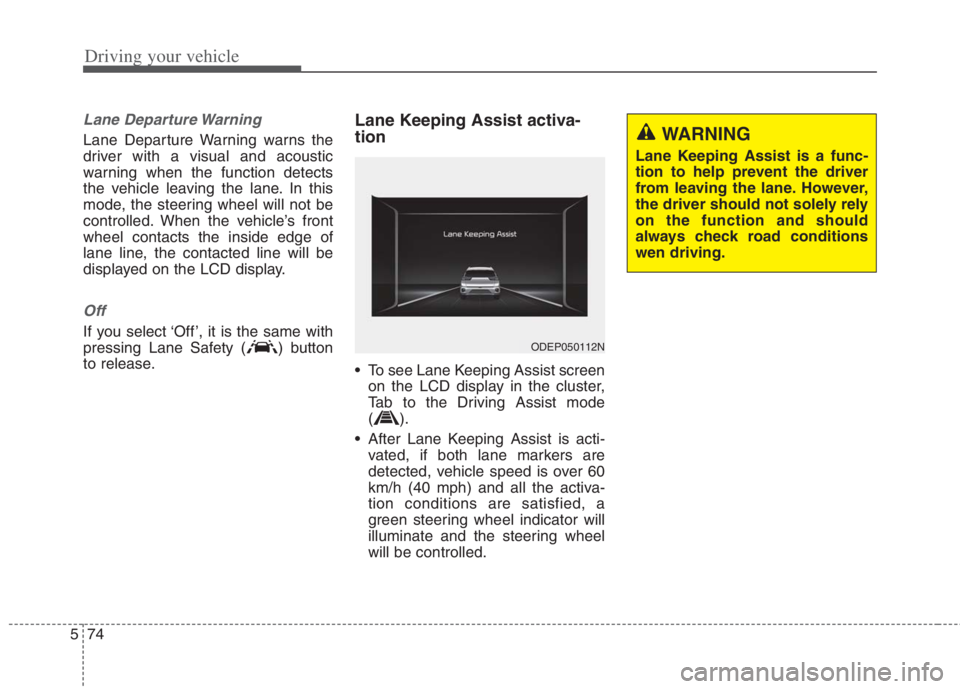
Driving your vehicle
74 5
Lane Departure Warning
Lane Departure Warning warns the
driver with a visual and acoustic
warning when the function detects
the vehicle leaving the lane. In this
mode, the steering wheel will not be
controlled. When the vehicle’s front
wheel contacts the inside edge of
lane line, the contacted line will be
displayed on the LCD display.
Off
If you select ‘Off’, it is the same with
pressing Lane Safety ( ) button
to release.
Lane Keeping Assist activa-
tion
To see Lane Keeping Assist screen
on the LCD display in the cluster,
Tab to the Driving Assist mode
().
After Lane Keeping Assist is acti-
vated, if both lane markers are
detected, vehicle speed is over 60
km/h (40 mph) and all the activa-
tion conditions are satisfied, a
green steering wheel indicator will
illuminate and the steering wheel
will be controlled.
ODEP050112N
WARNING
Lane Keeping Assist is a func-
tion to help prevent the driver
from leaving the lane. However,
the driver should not solely rely
on the function and should
always check road conditions
wen driving.
Page 402 of 684
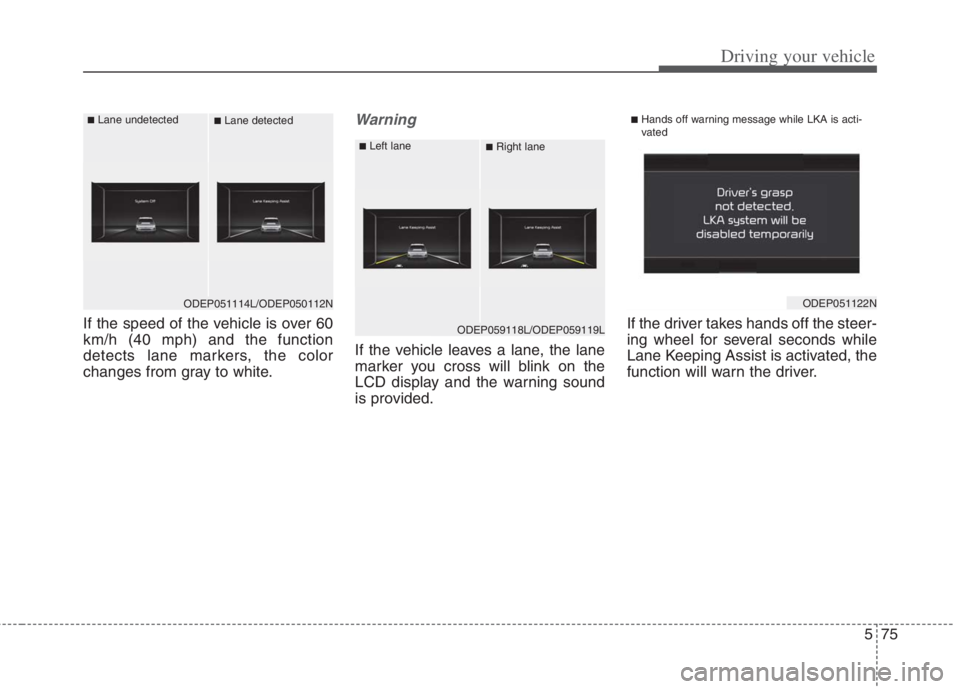
575
Driving your vehicle
If the speed of the vehicle is over 60
km/h (40 mph) and the function
detects lane markers, the color
changes from gray to white.
Warning
If the vehicle leaves a lane, the lane
marker you cross will blink on the
LCD display and the warning sound
is provided.If the driver takes hands off the steer-
ing wheel for several seconds while
Lane Keeping Assist is activated, the
function will warn the driver.
ODEP059118L/ODEP059119L
■Left lane■Right lane
ODEP051122N
■Hands off warning message while LKA is acti-
vated
ODEP051114L/ODEP050112N
■Lane undetected■Lane detected
Page 403 of 684
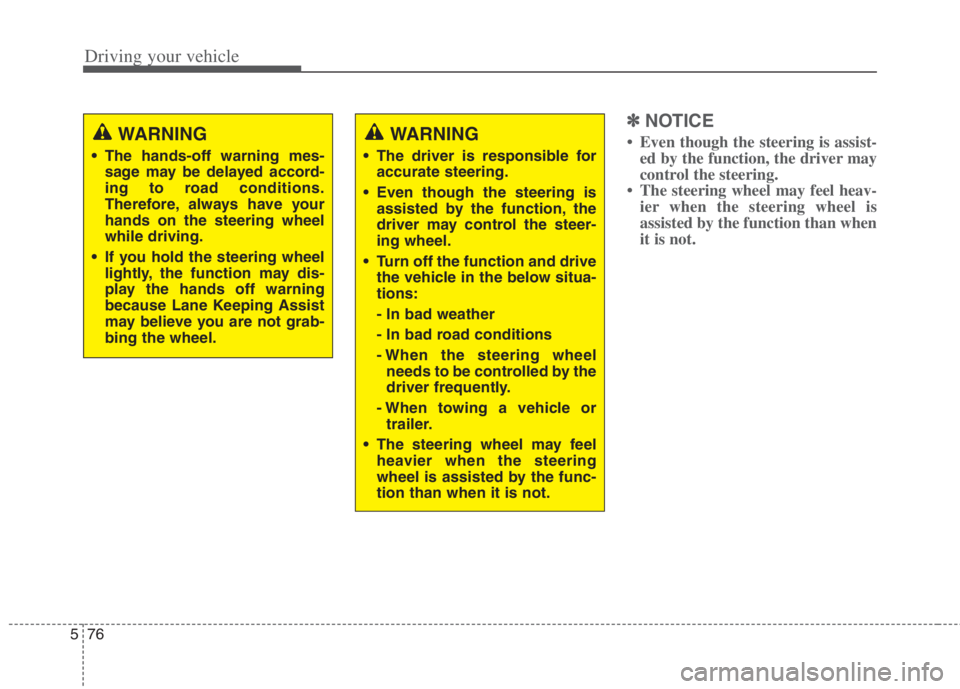
Driving your vehicle
76 5
✽
✽
NOTICE
• Even though the steering is assist-
ed by the function, the driver may
control the steering.
• The steering wheel may feel heav-
ier when the steering wheel is
assisted by the function than when
it is not. WARNING
The driver is responsible for
accurate steering.
Even though the steering is
assisted by the function, the
driver may control the steer-
ing wheel.
Turn off the function and drive
the vehicle in the below situa-
tions:
- In bad weather
- In bad road conditions
- When the steering wheel
needs to be controlled by the
driver frequently.
- When towing a vehicle or
trailer.
The steering wheel may feel
heavier when the steering
wheel is assisted by the func-
tion than when it is not.
WARNING
The hands-off warning mes-
sage may be delayed accord-
ing to road conditions.
Therefore, always have your
hands on the steering wheel
while driving.
If you hold the steering wheel
lightly, the function may dis-
play the hands off warning
because Lane Keeping Assist
may believe you are not grab-
bing the wheel.
Page 404 of 684
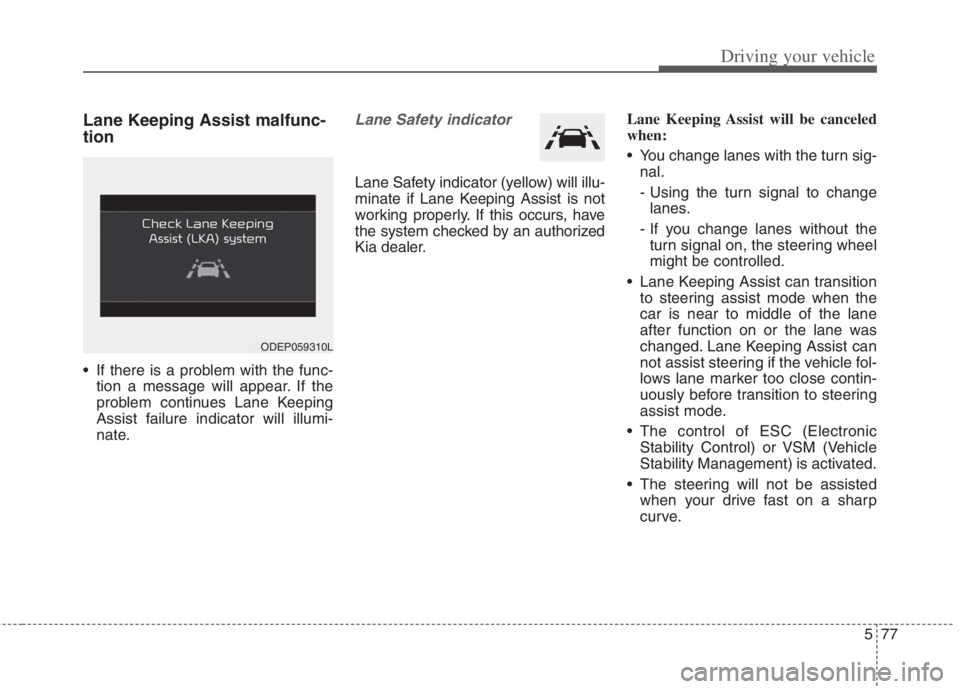
577
Driving your vehicle
Lane Keeping Assist malfunc-
tion
If there is a problem with the func-
tion a message will appear. If the
problem continues Lane Keeping
Assist failure indicator will illumi-
nate.
Lane Safety indicator
Lane Safety indicator (yellow) will illu-
minate if Lane Keeping Assist is not
working properly. If this occurs, have
the system checked by an authorized
Kia dealer.Lane Keeping Assist will be canceled
when:
You change lanes with the turn sig-
nal.
- Using the turn signal to change
lanes.
- If you change lanes without the
turn signal on, the steering wheel
might be controlled.
Lane Keeping Assist can transition
to steering assist mode when the
car is near to middle of the lane
after function on or the lane was
changed. Lane Keeping Assist can
not assist steering if the vehicle fol-
lows lane marker too close contin-
uously before transition to steering
assist mode.
The control of ESC (Electronic
Stability Control) or VSM (Vehicle
Stability Management) is activated.
The steering will not be assisted
when your drive fast on a sharp
curve.
ODEP059310L
Page 405 of 684
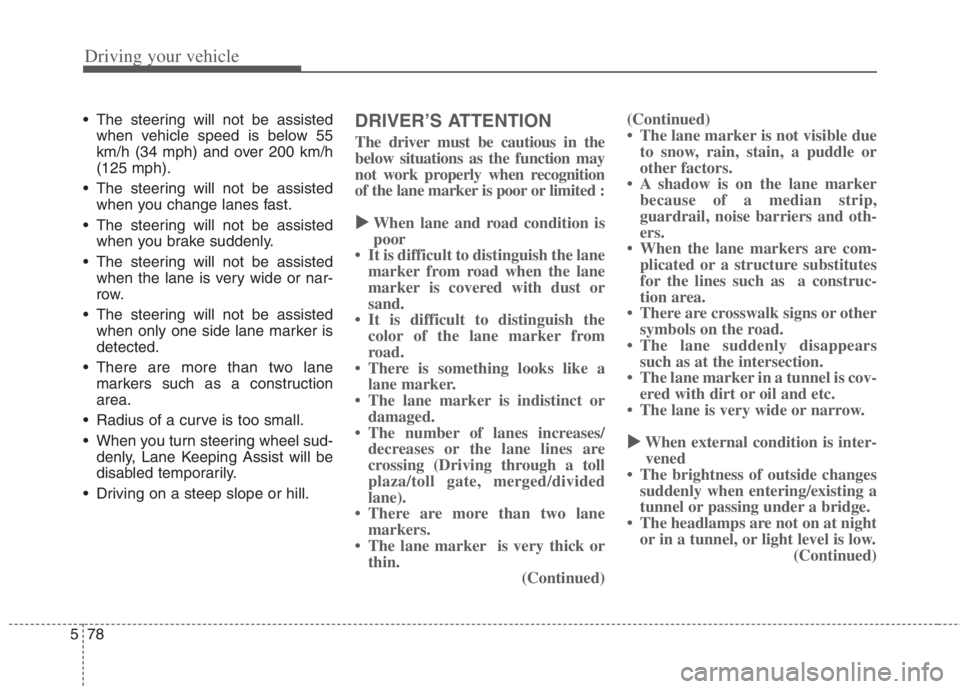
Driving your vehicle
78 5
The steering will not be assisted
when vehicle speed is below 55
km/h (34 mph) and over 200 km/h
(125 mph).
The steering will not be assisted
when you change lanes fast.
The steering will not be assisted
when you brake suddenly.
The steering will not be assisted
when the lane is very wide or nar-
row.
The steering will not be assisted
when only one side lane marker is
detected.
There are more than two lane
markers such as a construction
area.
Radius of a curve is too small.
When you turn steering wheel sud-
denly, Lane Keeping Assist will be
disabled temporarily.
Driving on a steep slope or hill.DRIVER’S ATTENTION
The driver must be cautious in the
below situations as the function may
not work properly when recognition
of the lane marker is poor or limited :
When lane and road condition is
poor
• It is difficult to distinguish the lane
marker from road when the lane
marker is covered with dust or
sand.
• It is difficult to distinguish the
color of the lane marker from
road.
• There is something looks like a
lane marker.
• The lane marker is indistinct or
damaged.
• The number of lanes increases/
decreases or the lane lines are
crossing (Driving through a toll
plaza/toll gate, merged/divided
lane).
• There are more than two lane
markers.
• The lane marker is very thick or
thin.
(Continued)(Continued)
• The lane marker is not visible due
to snow, rain, stain, a puddle or
other factors.
• A shadow is on the lane marker
because of a median strip,
guardrail, noise barriers and oth-
ers.
• When the lane markers are com-
plicated or a structure substitutes
for the lines such as a construc-
tion area.
• There are crosswalk signs or other
symbols on the road.
• The lane suddenly disappears
such as at the intersection.
• The lane marker in a tunnel is cov-
ered with dirt or oil and etc.
• The lane is very wide or narrow.
When external condition is inter-
vened
• The brightness of outside changes
suddenly when entering/existing a
tunnel or passing under a bridge.
• The headlamps are not on at night
or in a tunnel, or light level is low.
(Continued)
Page 406 of 684
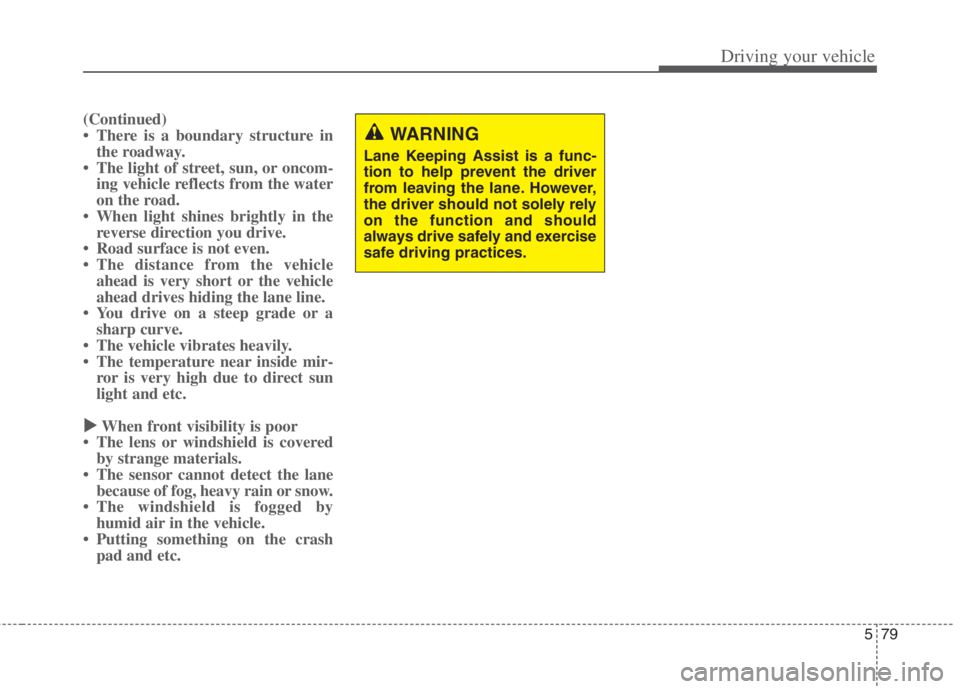
579
Driving your vehicle
(Continued)
• There is a boundary structure in
the roadway.
• The light of street, sun, or oncom-
ing vehicle reflects from the water
on the road.
• When light shines brightly in the
reverse direction you drive.
• Road surface is not even.
• The distance from the vehicle
ahead is very short or the vehicle
ahead drives hiding the lane line.
• You drive on a steep grade or a
sharp curve.
• The vehicle vibrates heavily.
• The temperature near inside mir-
ror is very high due to direct sun
light and etc.
When front visibility is poor
• The lens or windshield is covered
by strange materials.
• The sensor cannot detect the lane
because of fog, heavy rain or snow.
• The windshield is fogged by
humid air in the vehicle.
• Putting something on the crash
pad and etc.
WARNING
Lane Keeping Assist is a func-
tion to help prevent the driver
from leaving the lane. However,
the driver should not solely rely
on the function and should
always drive safely and exercise
safe driving practices.
Page 407 of 684
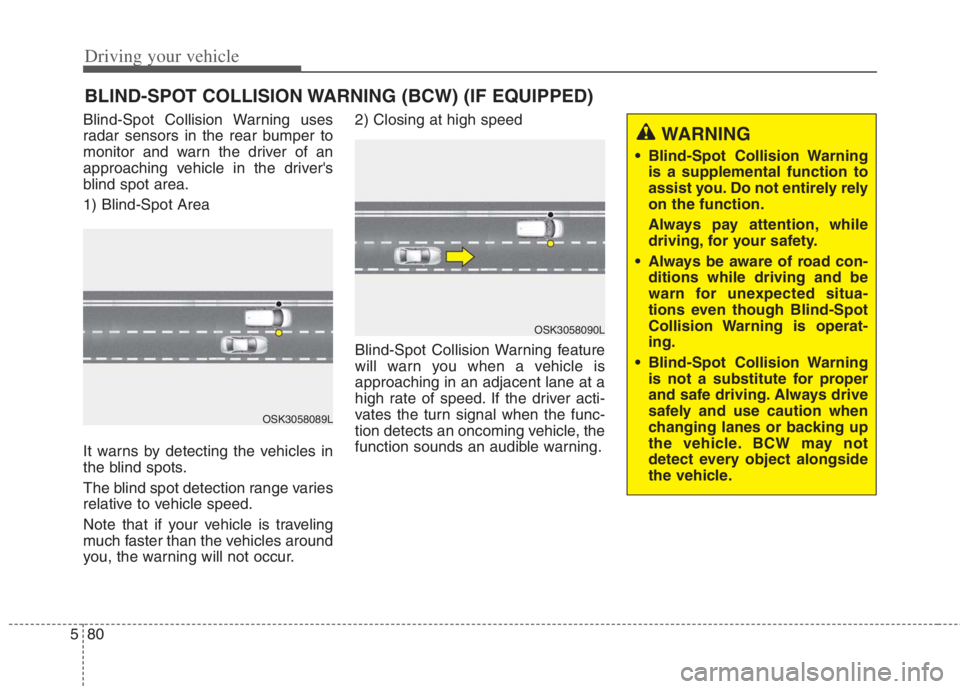
Driving your vehicle
80 5
Blind-Spot Collision Warning uses
radar sensors in the rear bumper to
monitor and warn the driver of an
approaching vehicle in the driver's
blind spot area.
1) Blind-Spot Area
It warns by detecting the vehicles in
the blind spots.
The blind spot detection range varies
relative to vehicle speed.
Note that if your vehicle is traveling
much faster than the vehicles around
you, the warning will not occur.2) Closing at high speed
Blind-Spot Collision Warning feature
will warn you when a vehicle is
approaching in an adjacent lane at a
high rate of speed. If the driver acti-
vates the turn signal when the func-
tion detects an oncoming vehicle, the
function sounds an audible warning.
BLIND-SPOT COLLISION WARNING (BCW) (IF EQUIPPED)
OSK3058089L
OSK3058090L
WARNING
Blind-Spot Collision Warning
is a supplemental function to
assist you. Do not entirely rely
on the function.
Always pay attention, while
driving, for your safety.
Always be aware of road con-
ditions while driving and be
warn for unexpected situa-
tions even though Blind-Spot
Collision Warning is operat-
ing.
Blind-Spot Collision Warning
is not a substitute for proper
and safe driving. Always drive
safely and use caution when
changing lanes or backing up
the vehicle. BCW may not
detect every object alongside
the vehicle.
Page 408 of 684
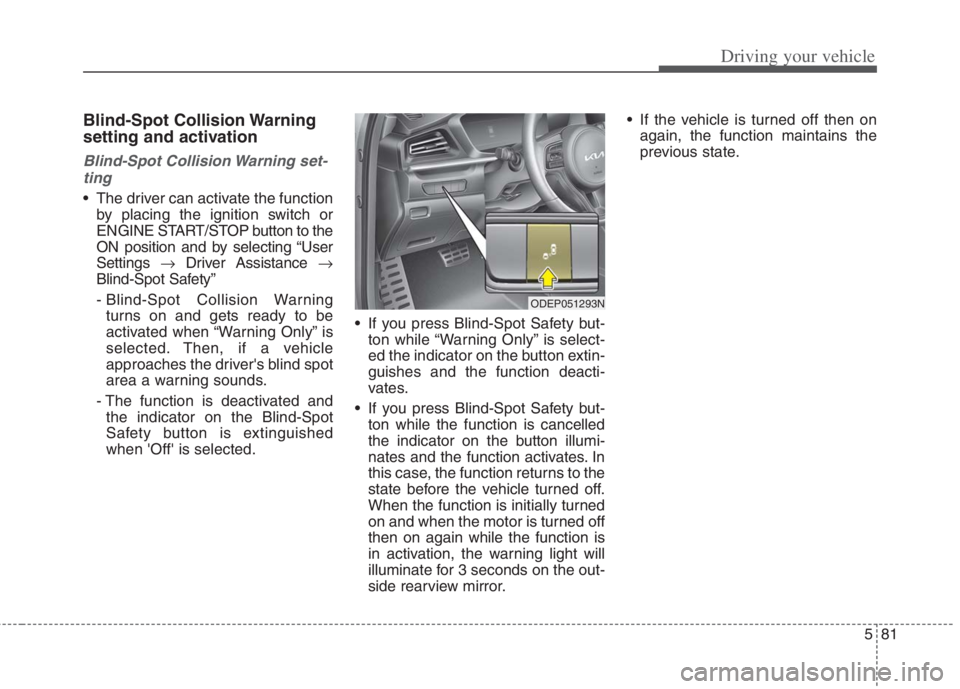
581
Driving your vehicle
Blind-Spot Collision Warning
setting and activation
Blind-Spot Collision Warning set-
ting
The driver can activate the function
by placing the ignition switch or
ENGINE START/STOP button to the
ON position and by selecting “User
Settings Driver Assistance
Blind-Spot Safety”
- Blind-Spot Collision Warning
turns on and gets ready to be
activated when “Warning Only” is
selected. Then, if a vehicle
approaches the driver's blind spot
area a warning sounds.
- The function is deactivated and
the indicator on the Blind-Spot
Safety button is extinguished
when 'Off' is selected. If you press Blind-Spot Safety but-
ton while “Warning Only” is select-
ed the indicator on the button extin-
guishes and the function deacti-
vates.
If you press Blind-Spot Safety but-
ton while the function is cancelled
the indicator on the button illumi-
nates and the function activates. In
this case, the function returns to the
state before the vehicle turned off.
When the function is initially turned
on and when the motor is turned off
then on again while the function is
in activation, the warning light will
illuminate for 3 seconds on the out-
side rearview mirror. If the vehicle is turned off then on
again, the function maintains the
previous state.
ODEP051293N
Page 409 of 684
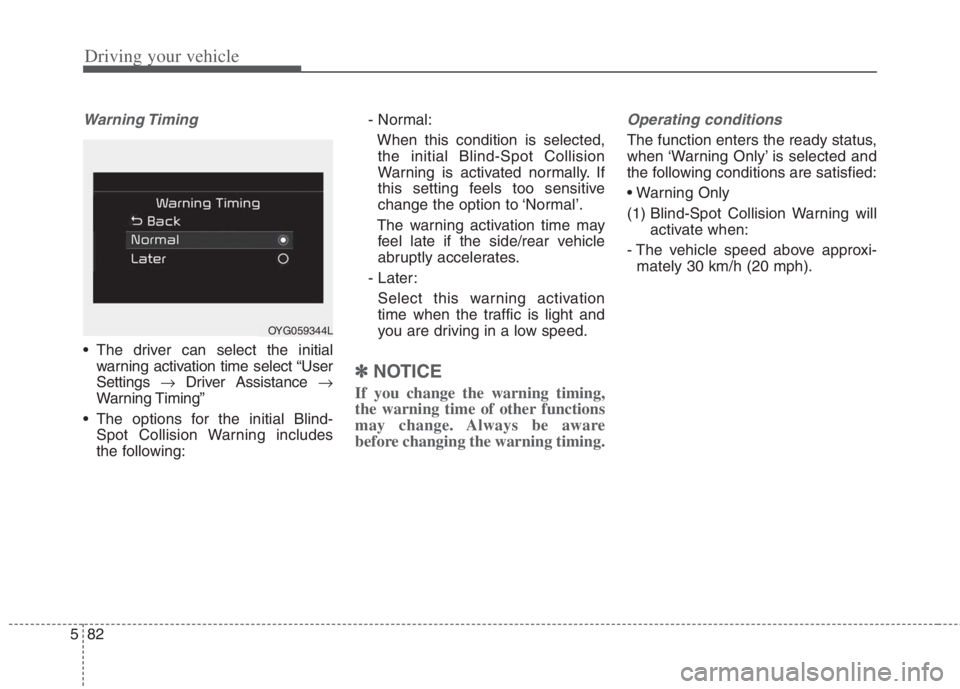
Driving your vehicle
82 5
Warning Timing
The driver can select the initial
warning activation time select “User
Settings Driver Assistance
Warning Timing”
The options for the initial Blind-
Spot Collision Warning includes
the following:- Normal:
When this condition is selected,
the initial Blind-Spot Collision
Warning is activated normally. If
this setting feels too sensitive
change the option to ‘Normal’.
The warning activation time may
feel late if the side/rear vehicle
abruptly accelerates.
- Later:
Select this warning activation
time when the traffic is light and
you are driving in a low speed.
✽ ✽
NOTICE
If you change the warning timing,
the warning time of other functions
may change. Always be aware
before changing the warning timing.
Operating conditions
The function enters the ready status,
when ‘Warning Only’ is selected and
the following conditions are satisfied:
(1) Blind-Spot Collision Warning will
activate when:
- The vehicle speed above approxi-
mately 30 km/h (20 mph).
OYG059344L
Page 410 of 684
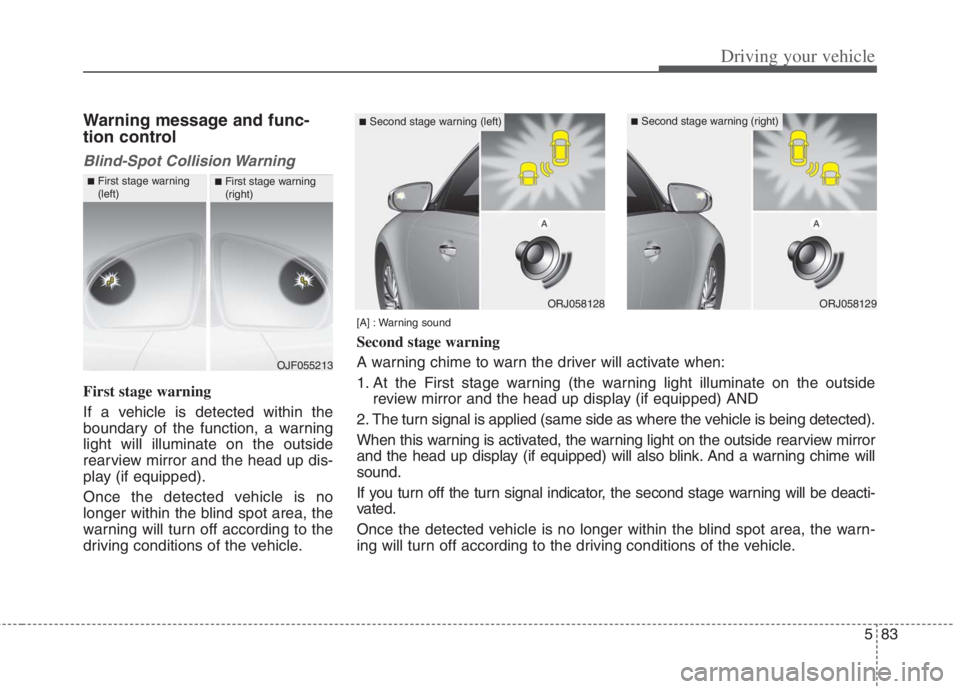
583
Driving your vehicle
Warning message and func-
tion control
Blind-Spot Collision Warning
First stage warning
If a vehicle is detected within the
boundary of the function, a warning
light will illuminate on the outside
rearview mirror and the head up dis-
play (if equipped).
Once the detected vehicle is no
longer within the blind spot area, the
warning will turn off according to the
driving conditions of the vehicle.
OJF055213
■First stage warning
(left)■First stage warning
(right)
ORJ058128ORJ058129
[A] : Warning sound
Second stage warning
A warning chime to warn the driver will activate when:
1. At the First stage warning (the warning light illuminate on the outside
review mirror and the head up display (if equipped) AND
2. The turn signal is applied (same side as where the vehicle is being detected).
When this warning is activated, the warning light on the outside rearview mirror
and the head up display (if equipped) will also blink. And a warning chime will
sound.
If you turn off the turn signal indicator, the second stage warning will be deacti-
vated.
Once the detected vehicle is no longer within the blind spot area, the warn-
ing will turn off according to the driving conditions of the vehicle.
■Second stage warning (left)■Second stage warning (right)